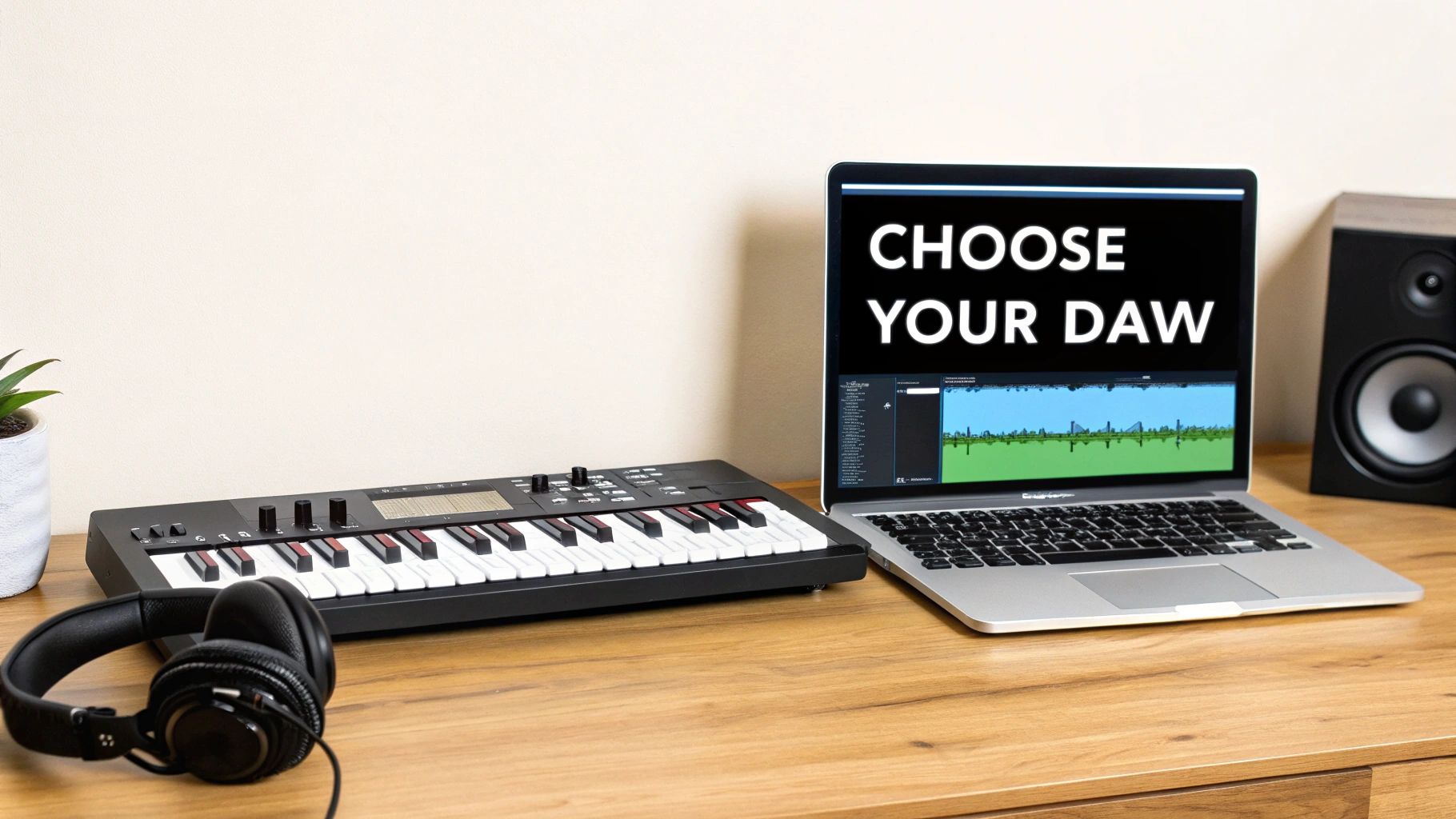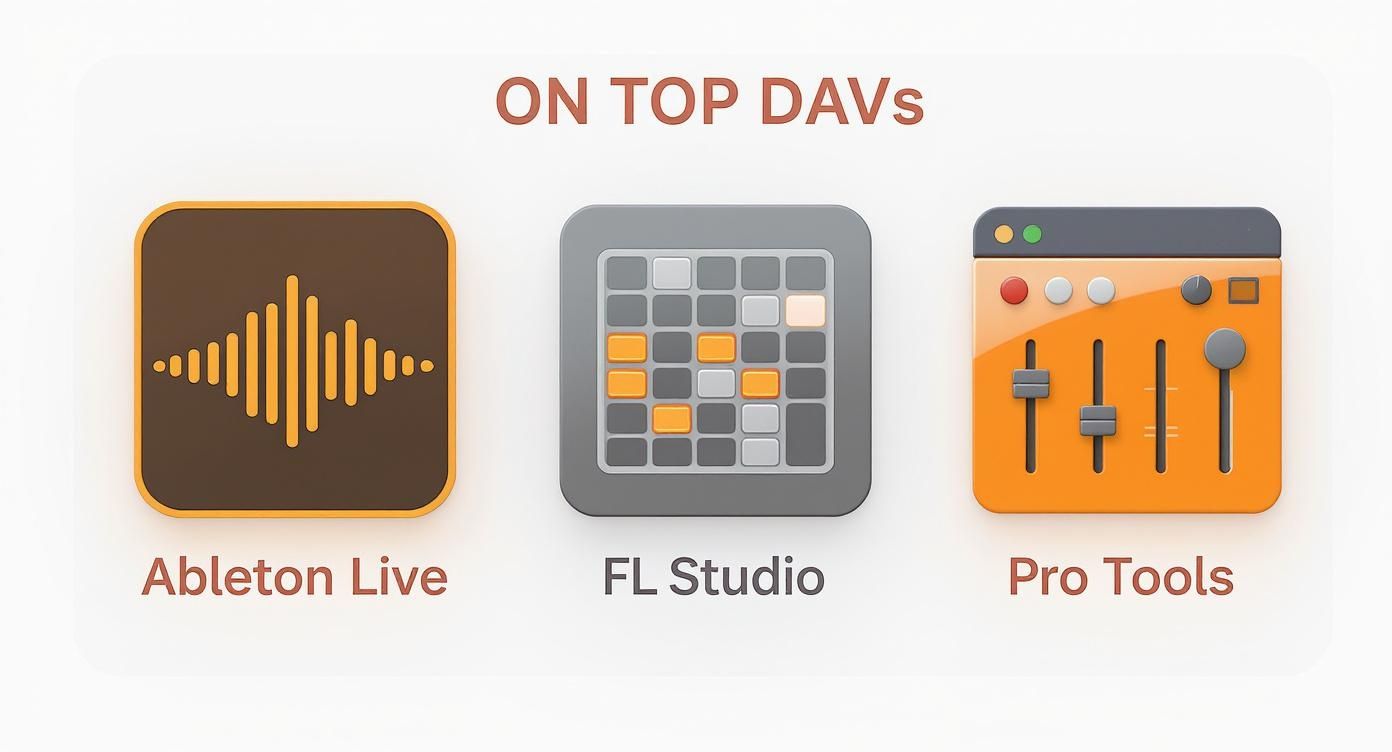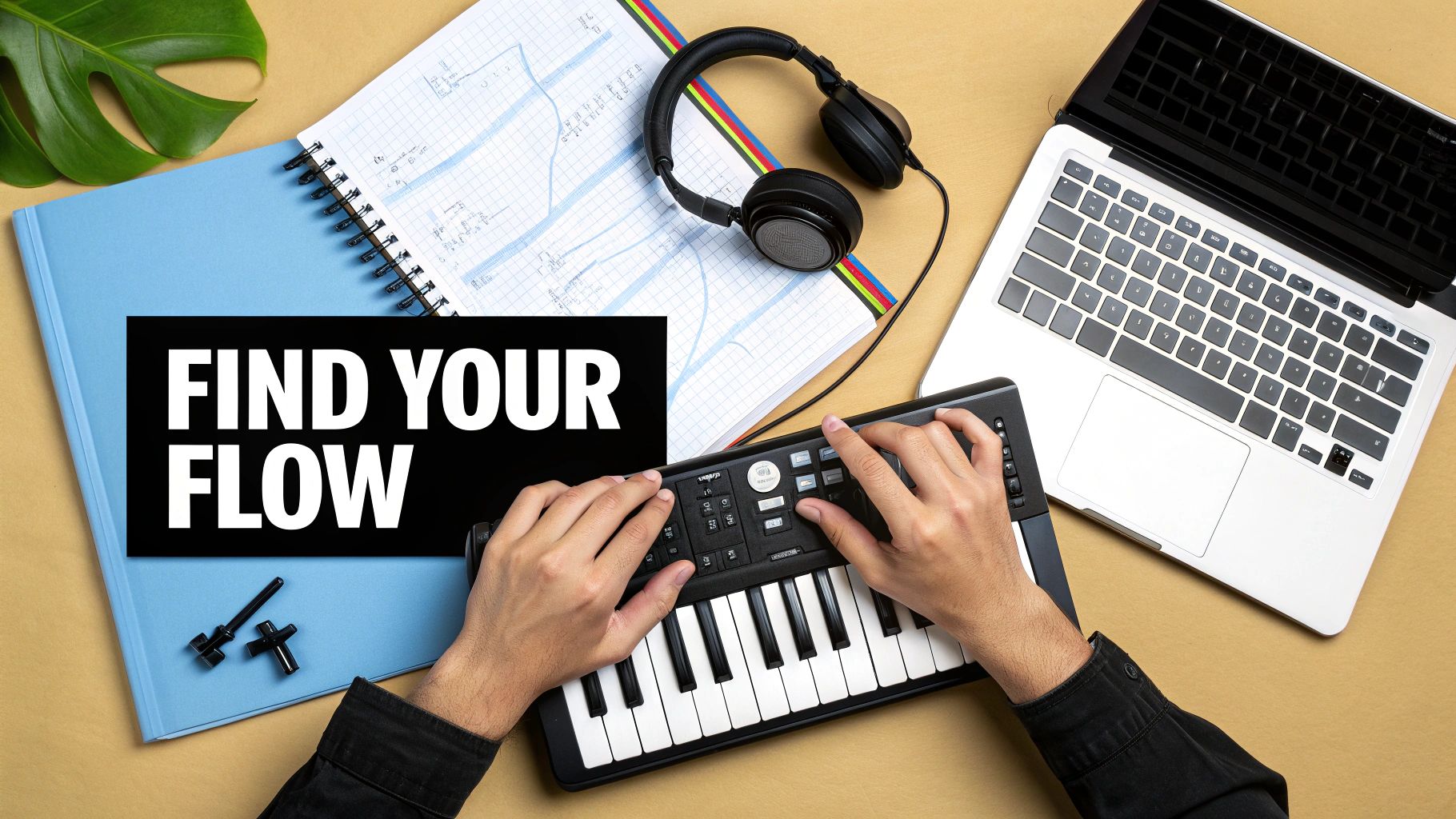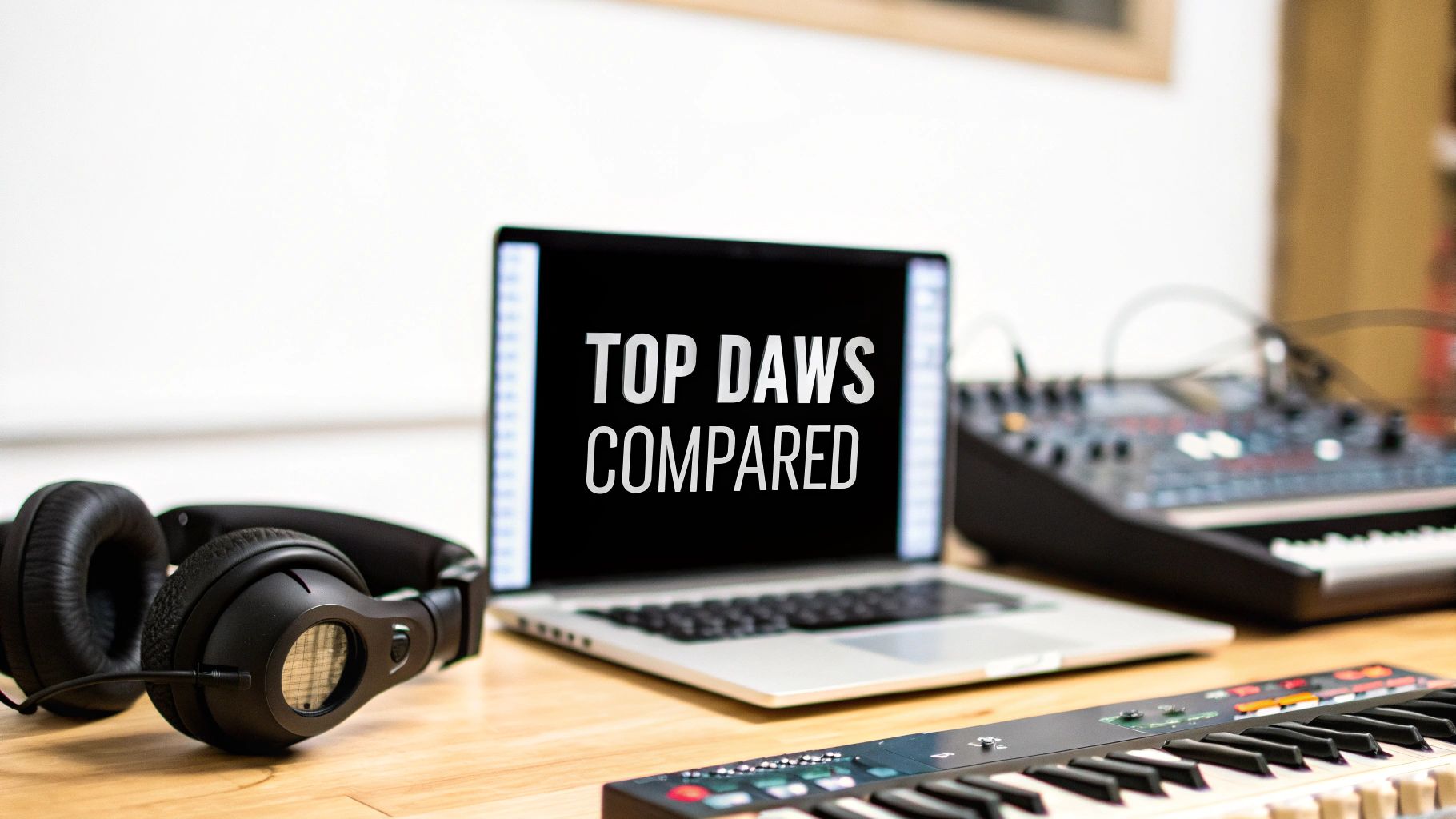Australia
For producers diving into the world of music production, three names consistently rise to the top: Ableton Live, celebrated for its fluid, creative workflow; Logic Pro, the powerhouse all-rounder for anyone on a Mac; and FL Studio, a legend in the beat-making scene. These Digital Audio Workstations (DAWs) are the heart of any modern studio, but figuring out which one is "best" really comes down to your personal goals, the genre you work in, and how you like to create.
Why Choosing the Right DAW Is Critical

Your DAW is so much more than a piece of software. It’s the digital space where your ideas are born, shaped, and polished into finished tracks. Think of it like a painter’s canvas and easel—it’s the entire framework for your creative output. Getting this choice right from the start is essential because a DAW’s workflow philosophy directly influences how you write, record, and mix your music.
This decision is especially important for the explosion of independent artists we're seeing today. Australia’s music market hit USD 245.5 million in 2024 and is forecast to more than double by 2033, a boom driven largely by creators using DAWs to produce and release music on their own terms. You can dig into the numbers in the Australia music market report.
Setting the Stage for Comparison
To help you make a smart decision, this guide offers a practical framework that goes beyond a simple list of features. We’ll look at how the unique personality of each DAW aligns with different creative goals.
| Factor to Consider | Why It Matters | Example Scenario |
|---|---|---|
| Workflow Philosophy | Determines how natural and intuitive the software feels for you. | An electronic producer might find Ableton's non-linear Session View perfect for live jamming and improvisation. |
| Plugin Ecosystem | Defines the sonic tools you get out of the box versus what you might need to buy later. | Logic Pro comes loaded with a massive library of high-quality stock plugins, saving you a lot of money upfront. |
| Performance Needs | Matches the software's stability and power to the demands of your projects. | A film composer needs a rock-solid DAW that can handle huge track counts and sync flawlessly with video. |
A DAW shouldn't just be powerful; it should feel like an extension of your creative mind. The less you have to fight the software, the more energy you can dedicate to making great music.
Getting a feel for these core differences is key. This same principle applies when picking tools in any creative field; for instance, choosing the best video editing software for beginners also depends heavily on workflow and what you plan to create. By the end of this guide, you’ll have a much clearer picture of how to match the right DAW to your artistic vision.
An Overview Of The Top Music Production Software
When you’re comparing DAWs for serious projects, five names come up again and again: Ableton Live, Logic Pro, FL Studio, Cubase and Pro Tools. Each brings a unique workflow flavour, depending on whether you’re chopping beats, scoring film or laying down live sessions.
Across the Asia-Pacific region, musical styles often dictate which DAW studios and artists pick. In fact, Australia alone holds a 4.87% share of APAC’s music business software market revenue projected for 2025, reflecting a solid appetite for advanced DAW setups and indie creativity. Discover more insights on market dynamics at cognitivemarketresearch.com
Key DAW Personalities
Every DAW carries its own creative blueprint, guiding how ideas evolve from spark to final mix. In Australia and neighbouring markets, those differences have spawned vibrant tutorial channels, plugin bundles and community forums.
- Ableton Live shines when you need on-the-fly inspiration, thanks to its Session View and clip triggering – a favourite for electronic acts and live performers.
- Logic Pro delivers a hefty suite of stock plug-ins and a linear workflow, perfect for singer-songwriters and anyone recording on Mac.
- FL Studio centres on pattern-first beat crafting via its channel rack and step sequencer, making it a go-to for beat makers and hip-hop producers.
- Cubase offers deep MIDI editing and scoring features, ideal for composers tackling orchestral charts or film scores.
- Pro Tools remains the industry standard for recording-heavy projects, smoothly handling large-scale studio sessions with razor-fine audio tracking.
Choosing a DAW often comes down to the workflow that feels most natural to your creative process.
If budget is a key factor, don’t miss this roundup of the best zero-cost options—explore top free digital audio workstations
Getting Started Examples
Concrete scenarios reveal how each DAW slots into real studio setups and creative goals.
- A Brisbane electronic duo flows through remixes in Ableton Live’s Session View, rearranging clips in seconds to keep energy high.
- In Sydney, a singer-songwriter sketches full demos in Logic Pro, leaning on Smart Tempo and Drummer to flesh out ideas fast.
- A Perth-based DJ programs beats in FL Studio’s piano roll and step sequencer, then bounces stems for club-ready mashups.
Real-world workflow examples can reveal which DAW vocabulary matches your creative language.
Regional Workflow Trends
| DAW | APAC Genre Focus | Notable Strength |
|---|---|---|
| Ableton Live | Electronic, Pop | Dynamic live-performance tools |
| Logic Pro | Singer-songwriter | Extensive plugin library on macOS |
| FL Studio | Hip-hop, EDM | Intuitive pattern-based sequencing |
| Cubase | Orchestral, Film | Precise MIDI scoring |
| Pro Tools | Rock, Studio Recordings | Industry-standard recording |
Analysis follows next.
Comparing the Leading DAWs Head-to-Head
Choosing the right music production software isn't about finding a single "winner". It's more about understanding the creative philosophy behind each platform and finding the one that clicks with how you work. We're going beyond a simple feature list to explore how these Digital Audio Workstations (DAWs) actually feel in practice. It's the difference between a tool that just works and one that genuinely sparks your next idea.
The following infographic gives you a quick visual summary of the core strengths of three industry leaders, with each icon representing its main workflow.

This snapshot shows how each DAW is really built for a specific creative style—from Ableton Live's performance-first approach to FL Studio's beat-making focus and Pro Tools' professional recording chops.
Ableton Live: The Improviser’s Playground
Ableton Live is built around a unique dual-view workflow that really sets it apart. While it has a traditional linear Arrangement View for sequencing tracks, its true magic lies in the Session View.
This non-linear grid lets you launch and combine musical clips—loops, samples, and MIDI patterns—in real time. It’s an incredibly intuitive system that encourages experimentation, which is why it’s a massive favourite among electronic producers, DJs, and live performers. Building a track feels less like writing a script and more like jamming with your own ideas.
Key Differentiator: The Session View fundamentally changes the creative process from a top-down arrangement to a bottom-up exploration of sound. This is exactly why it has become the gold standard for live electronic performance.
Ableton's stock devices, like the powerful Wavetable synthesiser and creative effects like Grain Delay, are designed for hands-on sound design. Its "Racks" system is brilliant, letting you group instruments and effects into custom macro-controlled devices that simplify complex sound-shaping in the studio and on stage. The trade-off? Its traditional mixing and audio comping tools, while capable, are often seen as less robust than what you’d find in DAWs like Pro Tools or Logic Pro.
Logic Pro: The All-In-One Studio
Exclusive to macOS, Logic Pro is famous for its massive feature set and incredible value. It offers a polished, traditional linear workflow that feels immediately familiar to anyone who has recorded music before, making it a top choice for singer-songwriters, bands, and film composers.
Where Logic really shines is its gigantic library of included content. Straight out of the box, you get a professional-grade suite of plugins, software instruments, and high-quality sounds.
Standout Logic Pro Features:
- Drummer: An intelligent virtual drummer that creates realistic grooves you can direct with simple controls.
- Smart Tempo: Automatically detects the tempo of any audio file and syncs your project to it, making it dead simple to work with loops and live recordings.
- Flex Pitch and Flex Time: Integrated tools for correcting the pitch and timing of audio, meaning you don't have to shell out for third-party software.
This all-in-one toolkit means you can produce a finished, mastered track without ever buying another plugin. For producers who want to avoid falling down the "plugin rabbit hole" and just focus on creating, this is a huge draw. Many creative principles in media production are shared, and if you're curious, you can learn about similar powerful tools in our guide to the best video editing software for Windows.
FL Studio: The Beat-Making Powerhouse
Originally known as FruityLoops, FL Studio has a long history and a fiercely loyal following, especially in the hip-hop and EDM scenes. Its workflow is built differently from the ground up, centring on the Channel Rack and Piano Roll.
The Channel Rack is a step sequencer that makes programming drum patterns ridiculously fast and intuitive. You just click in the steps where you want a sound to play, building patterns that can then be arranged in the Playlist. This pattern-based method is perfect for beat-makers who think in loops and layers.
FL Studio's Piano Roll is also widely considered one of the best in the business, with sophisticated MIDI editing tools that make writing complex melodies, chords, and glides feel effortless.
Key Differentiator: FL Studio's workflow prioritises pure speed for beat creation. The separation of the pattern (Channel Rack), arrangement (Playlist), and mixing (Mixer) lets you focus on one element at a time, building tracks from the ground up with incredible efficiency.
One of its most compelling selling points is the Lifetime Free Updates policy. Buy a license once, and you get all future versions for free—a massive long-term value compared to the paid upgrade cycles of most other DAWs. The main critique is that its detached window-based interface can feel cluttered, and its audio recording features aren't as developed as those in Pro Tools.
Cubase: The Composer's Toolkit
Cubase has been a cornerstone of music production for decades, respected for its deep MIDI editing capabilities and powerful compositional tools. It provides a robust, professional environment that appeals to film scorers, orchestral composers, and any producer who needs meticulous control over every musical detail.
Cubase excels in a few key areas:
- Expression Maps: A unique feature allowing composers to create dynamic, realistic performances with complex sample libraries by mapping articulations (like staccato or pizzicato) directly in the MIDI editor.
- Chord Track: An intelligent composition assistant that helps you prototype chord progressions and harmonise melodies across your entire project.
- VariAudio: A powerful, integrated pitch and time correction tool that rivals third-party options like Melodyne.
Cubase strikes a great balance between the creative, loop-based world and the traditional recording studio. While its interface can seem a bit dense to newcomers, its logical structure quickly reveals itself to be incredibly powerful once you get the hang of it.
Pro Tools: The Industry Standard
For decades, Pro Tools has been the undisputed standard in professional recording studios and post-production houses. Its reputation is built on rock-solid stability and an audio editing workflow optimised for pure speed in high-stakes recording sessions.
Pro Tools is rarely the first choice for making beats or electronic music from scratch. Its strengths lie in tracking live instruments, complex vocal comping, and detailed audio mixing. The editing workflow, heavily based on keyboard shortcuts, is designed for engineers who need to work quickly and efficiently under pressure.
Its deep integration with professional hardware, like Avid's own control surfaces, makes it the heart of many high-end studio setups. However, its creative tools, like virtual instruments and MIDI sequencing, have historically lagged behind competitors, though recent updates have closed the gap. The subscription-based model can also be a sticking point for producers on a tighter budget.
DAW Feature and Workflow Comparison
To help you see the key differences at a glance, here’s a side-by-side look at each DAW's ideal workflow, standout features, system needs, and pricing to help you find the perfect match.
| DAW | Best For | Key Feature | Minimum RAM | Entry Price |
|---|---|---|---|---|
| Ableton Live | Electronic Music & Live Performance | Session View for non-linear creation | 8 GB | $149 (Intro) |
| Logic Pro | Songwriting & All-Around Production | Massive included plugin/sound library | 8 GB | $319 (One-time purchase) |
| FL Studio | Beat Making & Hip-Hop/EDM | Pattern-based workflow & Piano Roll | 4 GB | $149 (Fruity Edition) |
| Cubase | Composition & Film Scoring | Advanced MIDI editing & Expression Maps | 8 GB | $159 (Elements) |
| Pro Tools | Professional Recording & Mixing | Industry-standard audio editing & stability | 16 GB | $149/year (Artist Subscription) |
Ultimately, the right DAW is the one that gets out of your way and lets you create. Hopefully, this breakdown gives you a clearer picture of which one might be the best fit for your musical journey.
What’s the Real Cost of Your DAW?
The sticker price on a DAW is just the tip of the iceberg. To make a smart financial decision, you need to look past the initial purchase and think about the total cost of ownership over its lifetime. This means weighing up everything from upgrade policies to the hidden costs of essential third-party tools.
A one-time purchase like Logic Pro offers a certain predictability. You pay once and that version is yours forever. On the other hand, subscription models like Pro Tools mean ongoing payments, but they often bundle in regular updates and premium support—a huge plus for professional studios where uptime is everything.
Subscriptions vs. Lifetime Updates
Another great model is the lifetime free update policy you get with FL Studio. The initial cost for a premium version might seem higher, but you'll never pay for another major update again. This can easily save you hundreds of dollars over a few years compared to DAWs that charge for each new version, which can run anywhere from $75 to $200 per upgrade.
The most cost-effective DAW isn't always the cheapest one upfront. It's the one that gives you the most long-term value by including the tools you actually need, without locking you into an expensive ecosystem of add-ons.
The Hidden Costs of Plugins and Sounds
Many producers quickly discover their "complete" DAW is anything but. The real expenses often pop up when you realise you need a better synthesiser, a more advanced vocal tuning plugin, or a professional-grade orchestral library. These individual purchases can add up fast, often costing more than the DAW itself. This is where a package like Logic Pro or Cubase Pro, with their massive library of built-in tools, can offer serious savings down the track.
This growing market of powerful and accessible software is a big reason the industry is booming. The global music production system market is forecast to jump from USD 6.42 billion in 2024 to USD 6.99 billion in 2025. You can find more insights about this trend and what it means for sound recording.
Ultimately, budgeting for your creative setup involves more than just the software. For instance, if you plan on making music videos or social media content, you’ll need to factor in other tools. You might find our guide on the best screen recording software helpful for capturing your production process for tutorials. By thinking about your entire workflow from day one, you can make a smarter, more complete investment.
Matching Your DAW to Your Creative Workflow

A Digital Audio Workstation is much more than just a set of tools; it’s a creative partner that shapes how you bring your ideas to life. Forget raw feature lists for a moment. The best way to choose your music production software is to picture how it fits into a real-world creative process. Seeing a DAW in action provides the context you need to make an intuitive, personal choice.
Each platform is built for different scenarios, encouraging specific artistic habits. By digging into these use cases, you can see which workflow clicks with your own musical goals, whether you're performing live, composing for film, or crafting beats in a home studio. This practical approach helps you find a DAW that doesn't just work, but actively inspires you.
The Electronic Artist and Ableton Live
Picture an electronic artist getting ready for a live set in a Melbourne club. Their goal is to build a dynamic, evolving performance that can feed off the crowd's energy. This is precisely where Ableton Live's Session View becomes indispensable.
Instead of a fixed, linear timeline, the artist works with a grid of musical clips—drum loops, basslines, synth melodies, and vocal samples. They can trigger these clips in any combination, layering sounds and building arrangements entirely on the fly. This non-linear approach transforms the laptop from a simple playback device into a genuine performance instrument, encouraging improvisation and spontaneous creativity.
- Typical Setup: A laptop running Ableton Live, a MIDI controller like the Ableton Push for hands-on clip launching, and a good audio interface.
- Workflow Tip: The artist groups instruments and effects into custom "Racks," mapping key parameters to a single knob for easy, expressive control during the performance.
- Essential Plugins: Stock plugins like
Wavetablefor sound design andGrain Delayfor creative effects are crucial for shaping a unique live sound.
The Film Composer and Logic Pro
Now, shift to a composer in a quiet Sydney studio, tasked with scoring a dramatic film scene. Their workflow demands precision, a massive sonic palette, and seamless integration with video. This is the natural environment for Logic Pro.
The composer works in a traditional linear view, arranging orchestral strings, powerful brass, and delicate piano parts against a video track. Logic Pro's deep scoring tools and its vast library of high-quality software instruments are absolutely essential. Features like Smart Tempo allow them to mould the music to the picture with ease, while the powerful mixer handles complex arrangements with hundreds of tracks without breaking a sweat.
For a composer, the DAW must be a rock-solid foundation for complex orchestration. Logic Pro provides an all-in-one ecosystem with the depth and stability needed for professional scoring work, from the initial sketch to the final mix.
The included sound library means the composer can access everything from cinematic percussion to realistic string ensembles without needing to invest heavily in third-party plugins. This integrated approach keeps the focus on composition, not technical headaches. Exploring other creative software can also offer new perspectives; our guide on the best photo editing software for beginners highlights how different tools empower visual storytelling.
The Hip-Hop Producer and FL Studio
Finally, imagine a hip-hop producer in their Perth bedroom studio, completely focused on crafting the perfect beat. Their workflow is fast, intuitive, and built around loops. This is the undisputed domain of FL Studio.
The producer's process kicks off in the Channel Rack, a legendary step sequencer that makes programming drum patterns incredibly quick. They can punch in kicks, snares, and hi-hats to build a foundation in seconds, then jump to the acclaimed Piano Roll to sketch out basslines and melodies. This pattern-based workflow lets them build complex arrangements by layering simple, repeatable ideas.
- Typical Setup: A powerful PC, a simple MIDI keyboard for playing in chords and melodies, and a solid pair of studio headphones.
- Workflow Tip: The producer uses Gross Beat to create classic stutter and pitch-shifting effects, adding movement and interest to their loops.
- Essential Plugins: The stock
Fruity Limiterfor punchy mastering and third-party synths are staples for creating those modern hip-hop sounds.
How to Confidently Choose Your Music Software
You’ve researched features and watched demos. Now comes the part that really matters—picking the DAW that feels right under your fingertips.
This simple framework steers you through crucial checkpoints, matching your gear and goals with the perfect software.
Decision Checkpoints
-
Evaluate Your Hardware
Compare your CPU, RAM and storage against each DAW’s published requirements. -
Use Trial Versions
Commit dedicated hours to test stability, workflow flow and CPU load. -
Assess Plugin And Community Support
Dive into forums and marketplaces to see where developers and users are most active.
Those steps ensure your chosen DAW can keep up with your creative workflow—no nasty surprises mid-session.
A DAW must feel rock-solid when you’re under deadline while still giving you room to experiment.
Narrow Your Options
-
Define Your Workflow Style
Electronic performers thrive on clip launching; film composers prefer a linear, track-by-track view. -
Align System Specs
Confirm OS compatibility and reserve at least 16 GB RAM for demanding projects. -
Compare 30-Day Trials
Keep a log of the features you use most and note any quirks or slowdowns. -
Research Real-World Feedback
Scour user threads and tutorial channels for insights you won’t find in marketing copy. -
Make Your Call
Pick the DAW that turns up again and again in your trial notes and aligns with your top priorities.
For security best practices in your setup, you might want to review our guide on antivirus software reviews to keep your system protected during production sessions.
To truly match your software to your creative process, it’s crucial to master your production workflow.
With this process, you’ll zero in on the right music production software and kick off your next project with confidence.
Final Tips
-
Trust Your Ears
Your DAW should feel intuitive the moment you hit record. -
Prioritise Common Features
Essentials like reliable comping and straightforward routing save you hours in the long run. -
Embrace Iteration
Early hiccups in trial runs help you refine your checklist and home in on your ideal platform.
Remember to document every step and compare notes before you commit.
Got Questions About Music Software?
Picking the right DAW always brings up a few common questions, especially around performance and how you’ll actually use it. Let's clear up some of the most frequent ones to help you choose the best music production software and get creating faster.
What Are The Minimum Computer Specs I Need For A DAW?
Most DAWs will run on a machine with at least 8 GB of RAM and a modern multi-core CPU. That's the baseline.
But if you're planning on running complex sessions loaded with virtual instruments and heavy plugin chains, you should really aim for 16 GB of memory and a fast SSD. It makes a world of difference. Always double-check the official specs for the exact version you plan to install before you commit.
Can I Move Projects Between Different DAWs?
Not directly, no. Each DAW uses its own proprietary file format, so you can't just open a Logic Pro project in Ableton Live. The standard workaround is to export every track as an individual audio or MIDI file—a process known as "exporting stems."
You then import those stems into your new DAW to rebuild the session. To make this go smoothly:
- Export your stems at the correct bit depth and sample rate to avoid quality loss.
- Label every track clearly so you know what's what when you import them.
- Use consolidated MIDI files to make editing your instrument parts much easier in the new software.
Do I Need To Buy Expensive Plugins Right Away?
Absolutely not. Every major DAW comes bundled with a solid collection of high-quality stock tools like EQs, compressors, and reverbs. Your first move should be to master those built-in devices.
This approach not only keeps your costs down but also forces you to learn the fundamentals of production before getting distracted by fancy third-party gear.
“Modern DAWs include plugins that can achieve professional results without extra purchases. Learn your stock tools inside and out first.” – Seasoned Producer
How Should I Compare Licensing Models?
DAW licensing can be a bit of a minefield, with everything from one-time purchases to monthly subscriptions on the table. You need to look at the long-term value.
Evaluate things like upgrade policies, access to support, and what plugins are included. A lifetime-update model like you get with FL Studio can offer incredible long-term savings. On the other hand, subscription plans often roll in all future updates and premium support, which might be a better fit for your needs.
The best advice? Trial a few different DAWs with your own projects. It’s the only way to find out if a particular workflow clicks with you before you spend any money.
Ready to streamline your software procurement and activation? Visit Digital Hub Key to explore genuine licence keys for Windows, Office and more.





